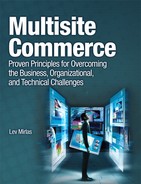Book Description
Plan, Manage, and Architect Multiple Web Sites for Maximum Efficiency and Business Value
For many companies, one Web site is no longer enough. Business strategy requires multiple Web sites, each with carefully targeted audiences and marketing approaches. However, managing multiple sites introduces costs and management headaches that conventional Web architectures and methodologies can’t handle. In Multisite Commerce, Lev Mirlas–the architect who pioneered the concept of a shared multisite platform with IBM® WebSphere® Commerce–introduces best practices and methodologies for implementing and managing multiple e-commerce sites efficiently and cost-effectively.
Mirlas begins by reviewing why multisite commerce is necessary and yet so challenging to execute. Next, he addresses multisite commerce from three perspectives: business, implementation, and technical. You’ll learn how to plan and implement a shared platform and use it to create and operate new sites that will remarkably lower incremental cost.
This book’s start-to-finish methodology provides a common language that everyone involved in multiple sites– from executives to project managers and technical architects to site administrators–can share.
Coverage includes
Identifying scenarios in which multiple sites are necessary
Systematically reducing the cost and complexity of establishing multiple e-commerce sites
Organizing the business to effectively administer multiple sites
Constructing a shared platform that makes it possible to build and deploy new sites faster than ever before
Giving sites their own personalities even though they are being built on shared infrastructure
Identifying the traps and landmines your project might encounter and maximizing the chances of success
Managing project scope, organizational politics, and shifting executive priorities
Choosing the best technical architecture pattern for your multisite scenario
Book Description
Plan, Manage, and Architect Multiple Web Sites for Maximum Efficiency and Business Value
For many companies, one Web site is no longer enough. Business strategy requires multiple Web sites, each with carefully targeted audiences and marketing approaches. However, managing multiple sites introduces costs and management headaches that conventional Web architectures and methodologies can’t handle. In Multisite Commerce, Lev Mirlas–the architect who pioneered the concept of a shared multisite platform with IBM® WebSphere® Commerce–introduces best practices and methodologies for implementing and managing multiple e-commerce sites efficiently and cost-effectively.
Mirlas begins by reviewing why multisite commerce is necessary and yet so challenging to execute. Next, he addresses multisite commerce from three perspectives: business, implementation, and technical. You’ll learn how to plan and implement a shared platform and use it to create and operate new sites that will remarkably lower incremental cost.
This book’s start-to-finish methodology provides a common language that everyone involved in multiple sites– from executives to project managers and technical architects to site administrators–can share.
Coverage includes
Identifying scenarios in which multiple sites are necessary
Systematically reducing the cost and complexity of establishing multiple e-commerce sites
Organizing the business to effectively administer multiple sites
Constructing a shared platform that makes it possible to build and deploy new sites faster than ever before
Giving sites their own personalities even though they are being built on shared infrastructure
Identifying the traps and landmines your project might encounter and maximizing the chances of success
Managing project scope, organizational politics, and shifting executive priorities
Choosing the best technical architecture pattern for your multisite scenario
Table of Contents
- Title Page
- Copyright Page
- Contents
- Preface
- Acknowledgments
- About the Author
- Introduction
- Part I. Business Perspective—Opportunities and Challenges of Multisite Commerce
- Chapter 1. Multisite Commerce Scenarios
- Chapter 2. The Need for a Shared Platform
- Chapter 3. Administration of Country Sites on a Shared Platform
- Chapter 4. Sharing and Caring
- Chapter 5. When Sharing Works
- Chapter 6. The Path to a Shared Platform
- Chapter 7. Cost Structure of Multiple Sites
- Chapter 8. Fundamental Requirements for a Multisite Platform
- Part II. Implementer’s Considerations for Efficient Multisite Commerce
- Part III. Technical Considerations for Efficient Multisite Commerce
- Index
